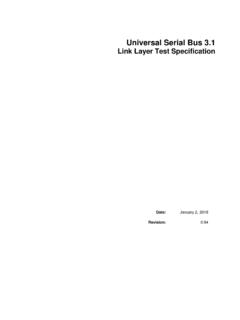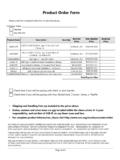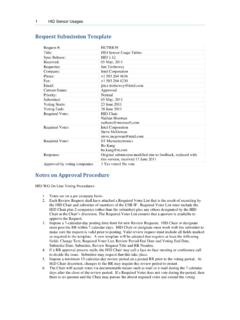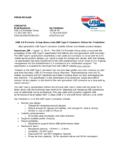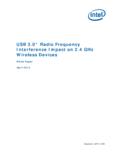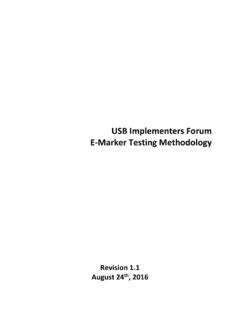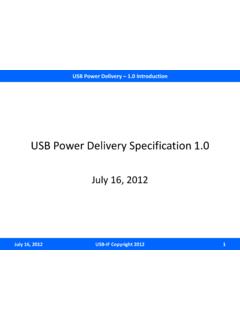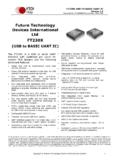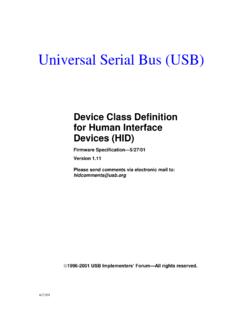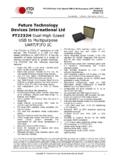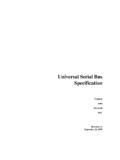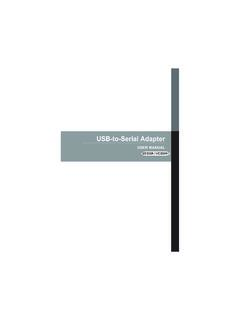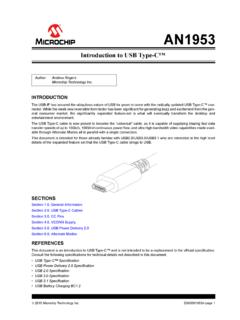Transcription of Universal Serial Bus (USB)
1 Universal Serial Bus (USB). Device Class Definition for Human Interface Devices (HID). Firmware Specification 6/27/01. Version Please send comments via electronic mail to: 1996-2001 USB Implementers' Forum All rights reserved. 6/27/01. iii Contents 1. Preface .. vii Intellectual Property Disclaimer .. vii Contributors .. vii Scope of this viii Revision History .. viii Document ix 2. Introduction .. 1. 1. 2. Related Documents .. 3. 3. Management Overview .. 4. 4. Functional Characteristics .. 7. The HID 7. 8. 9. 10. Device Limitations .. 11. 5. Operational 12. Device Descriptor 12. Report Descriptors .. 14. Generic Item Format .. 14. Item Parser .. 15. Usages .. 17. Reports .. 17. Strings .. 18. Format of Multibyte Numeric Values .. 19. Orientation .. 20. Null Values.
2 20. 6. 21. Standard Descriptors .. 21. Class-Specific Descriptors .. 21. HID 22. Report Descriptor .. 23. Items Types and 26. Short Items .. 26. 6/27/01. iv Contents Long 27. Main Items .. 28. Input, Output, and Feature 29. Collection, End Collection Items .. 33. Global Items .. 35. Local 39. 42. Physical 43. 7. Requests .. 48. Standard Requests .. 48. Get_Descriptor Request .. 49. Set_Descriptor 50. Class-Specific Requests .. 50. Get_Report Request .. 51. Set_Report 52. Get_Idle 52. Set_Idle Request .. 52. Get_Protocol Request .. 54. Set_Protocol Request .. 54. 8. Report Protocol .. 55. Report Types .. 55. Report Format for Standard 55. Report Format for Array 56. Report Constraints .. 57. Report 57. Appendix A: Usage Tags .. 59. Appendix B: Boot Interface 59. Protocol 1 (Keyboard).
3 59. Protocol 2 (Mouse) .. 61. Appendix C: Keyboard Implementation .. 62. Appendix D: Example Report Descriptors .. 64. Example Joystick Descriptor .. 64. Appendix E: Example USB Descriptors for HID Class 66. Device 66. Configuration Descriptor .. 67. Interface Descriptor (Keyboard) .. 67. HID Descriptor (Keyboard).. 68. Endpoint Descriptor (Keyboard).. 68. Report Descriptor (Keyboard).. 69. 6/27/00: Contents v Interface Descriptor (Mouse) .. 70. HID Descriptor (Mouse) .. 70. Endpoint Descriptor (Mouse).. 70. Report Descriptor (Mouse).. 71. String 72. Appendix F: Legacy Keyboard 73. Purpose .. 73. Management Overview .. 73. Boot Keyboard Requirements .. 74. Keyboard: Non-USB Aware System Design 75. Keyboard: Using the Keyboard Boot 75. Appendix G: HID Request Support Requirements.
4 78. Appendix H: Glossary 79. 6/277/00: vii 1. Preface Intellectual Property Disclaimer THIS SPECIFICATION IS PROVIDED AS IS WITH NO WARRANTIES. WHATSOEVER INCLUDING ANY WARRANTY OF MERCHANTABILITY, FITNESS FOR ANY PARTICULAR PURPOSE, OR ANY WARRANTY. OTHERWISE ARISING OUT OF ANY PROPOSAL, SPECIFICATION, OR. SAMPLE. A LICENSE IS HEREBY GRANTED TO REPRODUCE AND DISTRIBUTE. THIS SPECIFICATION FOR INTERNAL USE ONLY. NO OTHER LICENSE, EXPRESS OR IMPLIED, BY ESTOPPEL OR OTHERWISE, TO ANY OTHER. INTELLECTUAL PROPERTY RIGHTS IS GRANTED OR INTENDED. HEREBY. AUTHORS OF THIS SPECIFICATION DISCLAIM ALL LIABILITY, INCLUDING LIABILITY FOR INFRINGEMENT OF PROPRIETARY. RIGHTS, RELATING TO IMPLEMENTATION OF INFORMATION IN THIS. SPECIFICATION. AUTHORS OF THIS SPECIFICATION ALSO DO NOT.
5 WARRANT OR REPRESENT THAT SUCH IMPLEMENTATION(S) WILL. NOT INFRINGE SUCH RIGHTS. All product names are trademarks, registered trademarks, or service marks of their respective owners. Contributors While many people contributed to this document, only one contributor is listed from each organization. Company Contact Alps Mike Bergman Cybernet Tom Peurach DEC Tom Schmidt Intel Steve McGowan Key Tronic Corporation Jodi Crowe LCS/Telegraphics Robert Dezmelyk Logitech Remy Zimmermann Microsoft Corporation Mike Van Flandern NCR Bob Nathan Sun Microsystems Mike Davis ThrustMaster Joe Rayhawk 6/27/01. viii Device Class Definition for Human Interface Devices (HID) Version Scope of this Revision This version release incorporates all review requests approved at it's release date that apply to the USB Device Class Definition for Human Interface Devices (HID Specification).
6 Revision History Version Release date Description 6/27/01 Release. Incorporated HID review requests: 39, 53, 60, 61, and 62. 4/7/99 Release. Incorporated HID review requests: 18, 19, 20, 21, 22, 23, 25, 26, 28, 29, 30, 32, 35 and 52. Removed Usage Table sections. These can be found in the Universal Serial Bus HID Usage Tables document. 1/30/96 Release. 6/27/00: Preface ix Document Conventions This specification uses the following typographic conventions Example of convention Description Get_Report, Report Words in bold with initial letter capitalized indicate elements with special meaning such as requests, descriptors, descriptor sets, classes, or subclasses. Data, Non-Data Proper-cased words are used to distinguish types or categories of things. For example Data and Non-Data type Main items.
7 BValue Italicized letters or words indicate placeholders for information supplied by the developer. bValue, bcdName, wOther Placeholder prefixes such as b', bcd', and w' are used to denote placeholder type. For example: b bits or bytes; dependent on context bcd binary-coded decimal bm bitmap d descriptor i index w word [bValue] Items inside square brackets are optional.. Ellipses in syntax, code, or samples indicate and so ' where additional optional items may be included (defined by the developer). {this (0) | that (1)} Braces and a vertical bar indicate a choice between two or more items or associated values. Collection This font is used for code, pseudo-code, and End Collection samples. 6/277/00: 1. 2. Introduction Universal Serial Bus (USB) is a communications architecture that gives a personal computer (PC) the ability to interconnect a variety of devices using a simple four- wire cable.
8 The USB is actually a two-wire Serial communication link that runs at either or 12 megabits per second (mbs). USB protocols can configure devices at startup or when they are plugged in at run time. These devices are broken into various device classes. Each device class defines the common behavior and protocols for devices that serve similar functions. Some examples of USB device classes are shown in the following table: Device Class Example Device Display Monitor Communication Modem Audio Speakers Mass storage Hard drive Human interface Data glove See Also For more information on terms and terminology, see Appendix H: Glossary Definitions. The rest of this document assumes you have read and understood the terminology defined in the glossary. Scope This document describes the Human Interface Device (HID) class for use with Universal Serial Bus (USB).
9 Concepts from the USB Specification are used but not explained in this document. See Also The USB Specification is recommended pre-reading for understanding the content of this document. See Section : Related Documents. The HID class consists primarily of devices that are used by humans to control the operation of computer systems. Typical examples of HID class devices include: z Keyboards and pointing devices for example, standard mouse devices, trackballs, and joysticks. z Front-panel controls for example: knobs, switches, buttons, and sliders. z Controls that might be found on devices such as telephones, VCR remote controls, games or simulation devices for example: data gloves, throttles, steering wheels, and rudder pedals. 6/27/01. 2 Device Class Definition for Human Interface Devices (HID) Version z Devices that may not require human interaction but provide data in a similar format to HID class devices for example, bar-code readers, thermometers, or voltmeters.
10 Many typical HID class devices include indicators, specialized displays, audio feedback, and force or tactile feedback. Therefore, the HID class definition includes support for various types of output directed to the end user. Note Force feedback devices requiring real time interaction are covered in a separate document titled USB Physical Interface Device (PID) Class.. See Also For more conceptual information, see the USB Specification, Chapter 9, USB Device See Section : Related Documents. Purpose This document is intended to supplement the USB Specification and provide HID. manufacturers with the information necessary to build USB-compatible devices. It also specifies how the HID class driver should extract data from USB devices. The primary and underlying goals of the HID class definition are to: z Be as compact as possible to save device data space.

